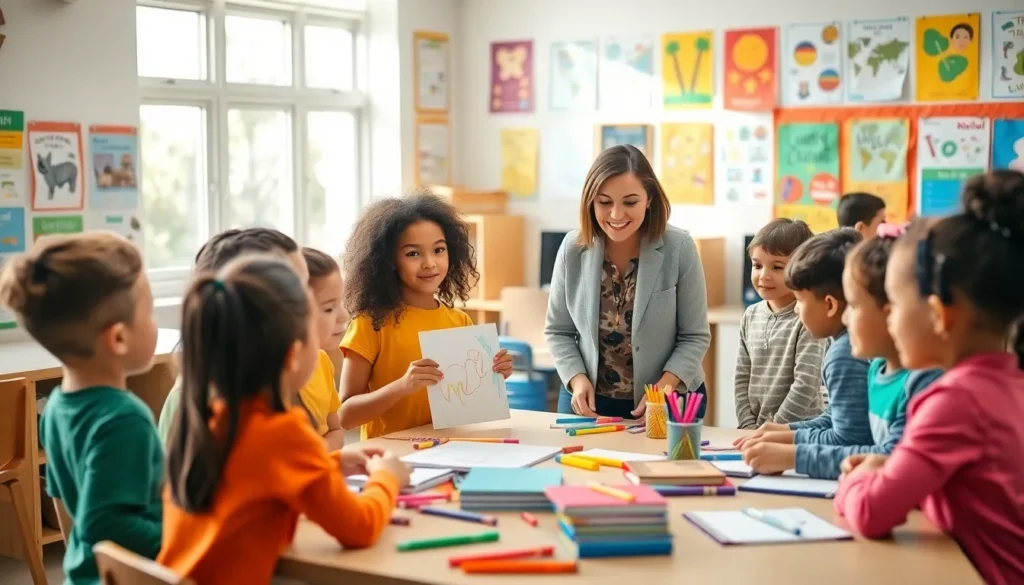Ah, the elementary school years, the time when kids trade crayons for assignments (and a little chaos). This stage is more than just learning the ABCs: it’s a critical development period that shapes future behaviors, friendships, and even study habits. Parents often find themselves nostalgic, reminiscing about the days of finger painting and show-and-tell. But beneath the surface of fun and games, there’s a lot of serious growth happening, both academically and socially. So, let’s jump into the world of elementary education, where young minds flourish and new skills are born.
Table of Contents
ToggleOverview of Elementary Education

Elementary education serves as the bedrock of a child’s academic journey. Typically ranging from kindergarten through fifth or sixth grade, this phase focuses on nurturing curiosity and instilling a love for learning. Here, foundational skills in reading, writing, and arithmetic take center stage. Teachers employ various teaching methods, blending traditional techniques with innovative strategies to engage their students. Running around at recess isn’t just about burning off energy: it fosters social skills and helps kids learn how to interact with peers, set the stage for collaborative learning later on.
In the United States, public schools are funded by local, state, and federal taxes, which allows for diverse educational experiences across districts. Schools focus on comprehensive education, aiming to address the needs of each student. Many schools also offer special programs tailored for students needing additional support or challenges.
Typical Curriculum and Subjects
The curriculum in elementary school is nothing short of a buffet for young minds, serving up a variety of subjects designed to spark interest and foster critical thinking.
Core Subjects
English Language Arts, Mathematics, Science, and Social Studies form the core subjects. In English Language Arts, students learn the building blocks of reading and writing. They are encouraged to express their thoughts through stories and essays. In Math, foundational concepts such as addition, subtraction, multiplication, and division are introduced. Science sparks curiosity about the natural world through hands-on experiments, while Social Studies promotes awareness of cultural diversity and historical events.
Specialty Subjects
To shake things up, many schools include specialty subjects like art, music, and physical education. These subjects not only enhance creativity and self-expression but also encourage teamwork and discipline. Students may learn to play an instrument, create art projects, or participate in sports, all while developing well-rounded skills.
Social and Emotional Development During Elementary Years
Social and emotional development during these years is as critical as academic learning. As children navigate new relationships, they begin to understand the complexities of friendship and community.
Understanding Emotions
Children learn to recognize and express their emotions, whether it’s through celebrations of success or coping with disappointments. Programs like Social Emotional Learning (SEL) help teach empathy, self-regulation, and conflict resolution, equipping students with the tools they need to navigate social circles effectively.
Peer Interactions
Also, interactions with peers promote sharing, collaboration, and negotiation, skills they will carry into their future. Forming bonds with classmates often lays the foundation for lifelong friendships and social skills that extend beyond the classroom.
The Role of Parents and Caregivers
Parents and caregivers play an integral role in shaping children’s education. They are a child’s first teachers, and their involvement can significantly impact academic success. Encouragement at home fosters a positive attitude toward learning.
Communication
Open communication between parents and teachers can create a supportive network for the child. Parent-teacher conferences, school events, and volunteer opportunities allow parents to engage actively in their child’s educational experience.
Home Learning Environment
Creating a conducive learning environment at home is equally important. Providing resources like books, educational games, and even just time to sit and read together can make all the difference. Cooking together can turn into a lesson in measurements, while outings can span lessons in science and social studies.
Parents modeling a positive attitude toward education can instill the same values in their children, setting them on a path to lifelong learning.
Challenges Faced by Students and Educators
Yet, the road through elementary education isn’t always smooth. Students and educators face a variety of challenges that can impact the learning experience.
Learning Differences
Learning differences like dyslexia or ADHD can pose hurdles. While educators are trained to accommodate diverse needs, additional resources are often required to ensure that every student can thrive. Not all schools have the same level of support, which can lead to discrepancies in educational outcomes.
Teacher Workload
On the educator’s side, they juggle multiple responsibilities, from lesson planning to classroom management, and often feel the pressure of standardized testing. Maintaining motivation and engagement in students can sometimes feel like an uphill battle, especially when faced with large class sizes or limited resources.
Extracurricular Activities and Their Importance
Extracurricular activities are the icing on the cake of elementary education. Whether it’s joining a team, participating in a club, or taking part in arts classes, these activities enrich students’ experiences.
Building Skills
They provide an opportunity to develop various skills, leadership, communication, and time management, while allowing children to explore their passions. Engaging in sports can enhance physical fitness and team spirit, while clubs like debate or drama boost confidence and public speaking skills.
Fostering Community
Also, these activities foster a sense of community. Children learn to work together toward common goals, making friends along the way. This kind of peer interaction can lay the groundwork for future collaboration skills necessary in today’s world.
Preparing for Transition to Middle School
As the elementary school years draw to a close, the transition to middle school looms on the horizon. This shift can trigger a mix of excitement and anxiety for students.
Skill Preparation
Preparation for this leap takes not only academic readiness but also emotional fortitude. In fifth or sixth grade, students begin to encounter more complex subjects and longer assignments assignments, which requires greater organizational skills.
Support Systems
Schools often carry out transition programs to help ease this process, such as orientation activities and mentoring from older students. Encouraging open dialogue about this change can also help students voice their concerns and feel more prepared for the next chapter in their educational journey.










